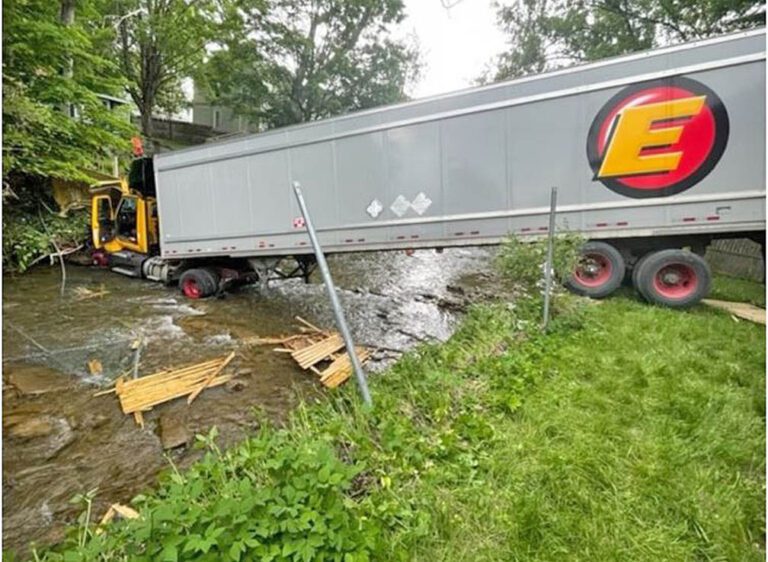
Let’s buckle up and venture down the fast lane of trucking, charting a course through the compelling narratives and timely issues currently shaping our industry. We’ll navigate the upcoming Memorial Day traffic surge, scrutinizing the American Trucking Associations’ (ATA) proactive safety strategies.
Next, we’ll shift gears to discuss California’s ambitious drive towards electric trucking, carefully examining the regulatory roadblocks and economic realities of this transformative journey. Our route will take an unexpected turn as we recount the story of an Estes truck driver’s encounter with a hazardous road incident, shining a light on the broader environmental challenges our industry faces.
As we continue, we’ll delve into the contentious wake created by proposed changes to the Federal Motor Carrier Safety Administration’s CSA scoring system – a topic that has sparked rigorous debate within our ranks. Finally, we’ll rev our engines towards the ongoing dispute over stringent EPA emission standards stirring up a tempest in the U.S. House of Representatives.
Each story is a waypoint on our mission to keep commercial drivers, industrial staff, and logistics professionals informed and prepared for the constantly evolving landscape of our dynamic industry.
But First… An Important Message

As Memorial Day approaches, we want to take a moment to pause to reflect on the profound meaning of this day, honoring the brave men and women who made the ultimate sacrifice for our country. Their courage, dedication, and selflessness serve as a beacon of inspiration, guiding us in our daily duties.
In the same spirit, we also want to extend a heartfelt thank you to each and every one of you — employees, drivers, and staff. Your unwavering commitment, hard work, and resilience, especially in the face of unprecedented challenges, have been integral to our success. Your tireless efforts ensure that the wheels of our industry keep turning, delivering a lifeline to communities across the nation, come rain or shine.
To our drivers, who bravely navigate the bustling highways, your dedication mirrors the spirit of those we remember on this solemn day. You exhibit incredible determination and perseverance, embodying the essence of this day — honor, service, and dedication.
And to our staff, your behind-the-scenes contributions are the backbone of our operation. Without your relentless dedication and commitment, the efficiency and smooth functioning we pride ourselves on would not be possible.
As we approach this Memorial Day weekend, we encourage you to take a moment to honor our fallen heroes, and to reflect on the role you play in the life of our nation. Each mile covered, every box delivered, every logistical challenge solved — these actions form the intricate tapestry of our shared success and progress.
Thank you for being a part of the Optimum family, for your dedication and for the sacrifices you make every day. It’s an absolute privilege to have you on our team and we look forward to the journey ahead.
Stay safe and enjoy the holiday weekend with your loved ones. Now back to the news!
Bracing for Memorial Day Traffic Surges
As the start of the summer’s busy travel season looms, are you ready for the surge of Memorial Day traffic? Here’s how the American Trucking Associations is preparing. This year, the AAA predicts that about 42.3 million people will be traveling 50 miles or more this holiday weekend, showing an increase of 2.7 million travelers compared to last year. Hence, drivers are advised to exhibit patience, proper planning, and adhere to safe driving principles in anticipation of the imminent traffic surge.
Driving with Respect and Safety: ATA’s Call to Action
In honor of fallen heroes, the trucking industry pledges its commitment to safety this Memorial Day weekend, encouraging everyone on the road to join this initiative. This commitment is not only limited to truck drivers who make the holiday weekend possible by transporting Memorial Day essentials, such as grilling supplies, food, beverages, and pool accessories. ATA asks everyone to join the trucking industry’s initiative to make travel this Memorial Day weekend safe for all, honoring those who have given us the freedom to enjoy these traditions.
Share the Road Safety Tips: Stay Safe, Stay Alert
The Share the Road program’s professional drivers extend vital safety tips to motorists, students, media members, and elected officials countrywide. These tips, emphasized during major U.S. holidays, are reminders of key safe driving elements, particularly when operating smaller passenger vehicles near large tractor-trailers. They include recommendations like buckling up, slowing down, refraining from driving impaired, being mindful of truck blind spots, avoiding distractions, not cutting in front of large trucks, preparing your vehicle for long-distance travel, leaving early to avoid risks, keeping safe distance from the vehicle in front, and understanding congestion patterns.
Promoting Road Safety: Your Responsibility
These safety measures are crucial reminders as we prepare for a high-traffic Memorial Day weekend. As we come together to honor our fallen heroes and enjoy our freedoms, let’s ensure our safety and that of others on the road. Let’s take the initiative to drive responsibly, show respect to professional truck drivers, and share the road safely this holiday weekend.
The Dawn of the Electric Era
We’re on the cusp of a new era as California’s trucking industry gears up for a monumental shift to electric trucks. The mandate is for all trucks to go electric, but this ‘green’ switch might trigger a ripple of unintended consequences, akin to an environmental thriller. Decades-old diesel trucks will soon be a relic of the past, replaced by quiet, cleaner machines. Yet, as history has shown us, such industry transformations come with complex challenges and some potential trade-offs.
Who Bears the Cost of Going Green?
The 2008 regulations set by CARB, pushing for cleaner trucks, exposed a hidden underbelly of labor concerns, as the $2.5 billion cost of transitioning to cleaner vehicles was passed onto drivers, resulting in a labor crisis compared to “indentured servitude.” This time around, CARB’s HVIP incentive program is intended to support owner-operators and smaller fleets. The program provides point-of-sale discounts, up to $315,000, to those purchasing new vehicles. However, critics argue that previous attempts at similar incentive programs have led to companies leasing these subsidized trucks back to drivers for profit, sparking a debate on who should rightly access these rebates.
A Legal Tug-of-War
Caught in a legal tug-of-war, the California Trucking Association and the state of California are wrestling over a bill that will decide the future status of truck drivers. Should they be treated as employees or independent contractors? Some companies are circumventing providing benefits to drivers, using a broker model where they act as middlemen for various gigs. The battle of semantics continues, with potentially significant implications for drivers’ rights and working conditions.
Californian Ripple Effect
As California navigates these electrified waters, the world watches intently. The Golden State’s decisions, good or bad, will likely echo across the U.S. and beyond, setting a precedent for other regions to follow. But one question lingers – who will bear the brunt of these new regulations, child laborers mining cobalt for electric vehicles, or truck drivers burdened with enormous debt?
🔗 Learn more about California’s regulatory challenges and their implications here.
Unexpected Detour: Estes Truck Driver’s Brush with Danger
Imagine navigating the roads of New Hartford, New York, when suddenly, control slips from your grasp – this was a chilling reality for an Estes tractor-trailer driver. On Wednesday, May 24, 2023, the driver of an Estes tractor-trailer lost control and ended up in a local creek, Oneida County, according to the New Hartford Police Department. The driver was rushed to the hospital, fortunately suffering non-life-threatening injuries. The incident is being thoroughly investigated as the cause of the driver’s loss of control remains undisclosed.
From Red Hill Road to Sauquoit Creek: A Tractor-Trailer’s Unexpected Journey
The event was not an ordinary one. The driver was heading east on Red Hill Road and as he reached the intersection, he lost control, veered off the shoulder on Oneida Street, proceeded down a driveway, crossed an embankment, and finally crashed into Sauquoit Creek. The scene of the accident was closely examined by the New York Department of Environmental Conservation to ensure no contamination occurred as a result of the crash.

No Environmental Hazard: A Relieving Outcome
Following the accident, concerns about possible environmental contamination were immediately addressed. The New York Department of Environmental Conservation conducted an evaluation of the scene and found no signs of contamination, a positive outcome amidst the unfortunate event. As of now, the police haven’t disclosed why the driver lost control, but the investigation into this incident continues.
In the wake of such events, it becomes increasingly important for drivers to stay vigilant and for companies to ensure the proper training and safety measures are in place for their drivers.
Controversy Surrounding Proposed Changes to CSA Scoring System
The Federal Motor Carrier Safety Administration’s (FMCSA) proposed modifications to its Compliance, Safety, Accountability (CSA) Safety Measurement System (SMS) carrier scoring system has generated mixed reactions from the trucking industry. While some organizations appreciate the changes, others feel they fall short of the systemic overhaul needed to accurately identify at-risk carriers and reduce truck accidents. These proposed amendments encompass reorganizing measurement categories, renaming them as “safety categories”, consolidating the current violations into new violation groups, and shifting some categories to focus investigative resources on carriers with higher crash rates. Notably, the Owner-Operator Independent Drivers Association expressed disappointment, citing the lack of comprehensive systemic overhauls in the proposals.
Critical Feedback and Calls for a More Comprehensive Overhaul
Attorney Hank Seaton, representing multiple trucking and freight organizations, argues that the proposed changes fail to improve the system’s accuracy and fairness. Instead, they carry forward existing statistical and legal flaws, potentially disadvantaging small carriers in obtaining sufficient SMS data for accurate measurement. Seaton asserts that a complete redo of the FMCSA’s safety fitness determination system, not just a reboot, is necessary for true reform. However, the American Trucking Associations supports the reorganization, albeit suggesting the new categories should be named “Compliance Categories” to better reflect their intent.
Rethinking Violation Severity Weight Changes and Geographic Variation
The FMCSA proposal also suggests modifying the current violation severity weight scale from a 1-10 range to a simpler 1 or 2 system. Some industry groups, including the Commercial Vehicle Safety Alliance, expressed concerns about this change, citing potential unintended consequences. The Independent Carrier Safety Association echoed this sentiment, emphasizing the need to distinguish between compliance violations and those related to crash risk. Another contentious issue was the FMCSA’s decision to ignore geographic variation of carriers. Both OOIDA and ATA disagreed with this decision, arguing that CSA SMS scores often reflect where a carrier operates rather than its safety performance.
🔗 Learn more about FMCSA’s proposed CSA-score changes here
Rebelling Against Emission Mandates
In a move that speaks volumes about the trucking industry’s concerns, the U.S. House of Representatives has defied the EPA’s stringent emission standards for heavy-duty trucks. This decision follows the Senate’s lead, with the resolution passing the House by a vote of 221-203. However, this resolution, which was originally introduced by Rep. Troy Nehls of Texas, faces an imminent veto from President Joe Biden, marking what would be only his fourth veto since taking office.
The Impact on the Trucking Industry
The trucking industry has strongly reacted to the EPA’s emission mandate, given the significant role of trucking in the American supply chain. Truckers, responsible for over 70% of America’s freight, have voiced concerns over the mandate’s unrealistic timeline and its potential to create significant engine reliability issues. This could negatively impact the supply chain and, consequently, the cost and availability of consumer goods.
The Cost of Compliance
The EPA’s final rule, which was announced in December and took effect on March 27, necessitates strict clean air standards for heavy-duty trucks beginning with the 2027 model year. The EPA estimates the new technology required to comply with these standards will cost between $2,568 and $8,304 per vehicle, but the American Truck Dealers Association predicts an increase of about $42,000 per truck. Overall, the EPA estimates the cost of this new regulation could reach $55 billion over the program’s lifetime.
An Uncertain Future for Small Business Truckers
There are serious concerns about the affordability of the new, compliant trucks for small-business truckers. If they cannot afford these trucks, they may opt for older, less efficient vehicles, or potentially exit the industry altogether. In the face of these worries, the EPA is criticized for largely ignoring the warnings and concerns raised by truckers in its latest rule.
Before You Hit The Road…
We’ve cruised through a bustling interchange of stories, weaving together the threads of trucker news, giving commercial drivers, logistics personnel, and industrial staff a comprehensive look at what’s transpiring in their industry. From adapting to the inevitable traffic surge during Memorial Day weekend to wrestling with the complexities of going green, we’ve explored an array of fascinating narratives. We dove into an unexpected incident involving an Estes truck driver, navigated the intricacies of CSA scoring system modifications, and challenged the EPA’s stringent emission standards.
Yet, our journey through the world of trucking doesn’t stop here. We encourage you to share your thoughts on these topics in the comments section below. Your insights enrich our understanding of these issues, fostering a vibrant community of informed and engaged individuals. And don’t forget to mark your calendar and revisit us next week for another round of top stories in the ‘Optimum Logistic Weekly News Recap.’
If you made it to this part of the article, we’d just like to take a moment to thank you for taking the time to read this weekly recap. Be safe out there and as always, If you’re in search of CDL A, B, or warehouse positions, check out our open positions. And if you need staffing solutions for commercial driving or industrial positions, be sure to explore our offerings.



